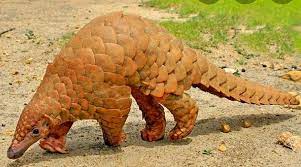01 Jan 2022 Indian pangolin

Indian pangolin- Today Current Affairs
- Recently a radio tagged Indian pangolin was released at Nandan kanan Zoological Park (Odisha) following the soft release protocol and provision for post-release monitoring.
- In radio-tagging the movements of a wildlife are tracked by a transmitter. In the past, many wildlife such as tigers, leopards and migratory birds have also been tagged.
Introduction:
- Pangolins are scaly anteater mammals and have large protective keratin scales covering their skin. These are the only known mammals to have this characteristic.
- It uses these keratin scales as armor to shield itself from threats by rolling like a ball against predators.
- Insectivorous – Pangolins are nocturnal and their diet consists mainly of ants and termites, which they catch using their long tongues.
- Of the eight species of pangolin, the Indian pangolin (Maniscrassicaudata) and the Chinese pangolin (Manispentadactyla) are found in India.
Difference: The Hindu Analysis
- The Indian pangolin is a large anteater covered with 11-13 rows of stripes on the back.
- The Indian pangolin also has a terminal scale on the underside of its tail, which is absent in the Chinese pangolin.
Natural habitat:
Indian Pangolin:
- The Indian pangolin is widely found in the rest of India except the arid regions, the high Himalayas and the Northeast. This species is also found in Bangladesh, Pakistan, Nepal and Sri Lanka.
Chinese pangolin
- The Chinese pangolin is found in the Himalayan foothills in eastern Nepal, Bhutan, northern India, north-eastern Bangladesh and southern China.
Pangolin threatened in India
- Its meat trade in East and Southeast Asian countries, especially China and Vietnam, and poaching for local consumption (such as as a protein source and traditional medicine) are the main reasons for its extinction.
- It is believed that these are the mammals of the world that are trafficked in large quantities.
Conservation status: The Hindu Analysis
- In the Red List of International Union for Conservation of Nature-IUCN, the Indian Pangolin is listed as Endangered, while the Chinese Pangolin is classified as Critically Endangered.
- Listed under the Wildlife (Protection) Act, 1972 Schedule-I.
- CITES: All pangolin species are listed in Appendix-I of the Convention on International Trade in Endangered Species (CITES).
Nandan kanan Zoological Park: Today Current Affairs
- It is located 15 km away from Bhubaneswar, the capital of Odisha. It was inaugurated in the year 1960.
- It is the first zoo in the country to become a member of the World Association of Zoos and Aquariums (WAZA).
- The ‘World Association of Zoos and Aquariums’ is a global alliance of regional associations, national associations, zoos and aquariums dedicated to the care and conservation of animals and their habitats around the world.
- It is recognized as a major zoo for breeding Indian pangolin and white tiger.
- Leopards, mouse deer, lions, rats and vultures are also found here.
- It was also the world’s first captive crocodile breeding center where alligators were kept in the year 1980.
- The State Botanic Garden of Nandan kanan is one of Odisha’s leading plant conservation and nature education centers.
In this article we mention all information about Indian pangolin Today Current Affairs.
yojna ias daily current affairs 1 January 2022


No Comments